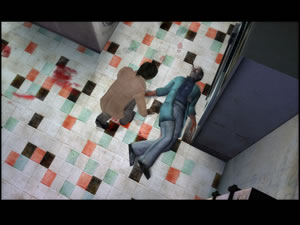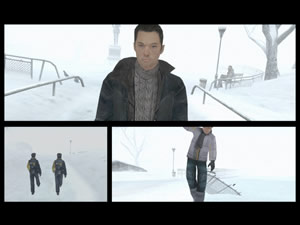A Dark, Reddish Blue.
Indigo Prophecy is just the damndest thing. Here I’ve been playing it on and off (it’s already available in Europe under the only marginally less yawn-inducing name of Fahrenheit)…and I’m at an uncharacteristic loss for words.
But for those of you unfamiliar with the buzz, I’ll attempt to locate the missing verbiage. Indigo Prophecy is a self-proclaimed original, high production-value, mature-themed cinematic murder-mystery/cop-procedural adventure-game thriller, crammed to the starfish with all manner of showy, bullet-time/wire-fu antics, not to mention heavy occult elements that reference Roswell-esque government secrets, repressed childhood memories, psychic powers and meteorological apocalypse.
[Takes breath.]
Further, the game’s dialogue choices run under an ever-present timer, and the default action challenges – which comprise much of the game – run the antediluvian gaming gamut, from following the leader like Simon to maniacally pounding buttons like Track & Field.
What I’m saying is, this is a game that absolutely should not work, not even in the conceptual stage. It should implode under its own mechanical simplicity and the gravity of its own theatrical, overreaching mass. It should not still be in my Xbox, daring me to start another ‘movie’ (particularly after the evil, evil thing the file-save system did to me last week).
And yet, as Homer Simpson says…here we are. It’s the damndest thing.
It also just goes to show the importance of a gripping story, decent writing, solid voice-acting, attention to overall production and giving your audience some credit.
Opening on a bitter, snowy night in New York, Indigo Prophecy stars Lucas Kane, a nobody-in-particular thirty-something IT guy who works in a bank. In a grisly opening scene that segues into a brief tutorial, we see Kane brutally knife a stranger to death in a diner restroom – apparently under a mind-controlling trance, and with periodic flashes of some parallel, occultic event.
As soon as the victim breathes his last on the restroom floor, Kane violently comes to his senses, leaping off the victim, bewildered and terrified at what he has done – not only at the horror and wrongness of it, but at the realization that a.) his arms and face are spattered with blood, and b.) there’s a NYPD cop sipping coffee in the diner just outside the restroom’s exit. And then the 24-style split-screen thing kicks in…showing us the cop, headed for the restroom…
Thus begins the game’s sink or swim-in-blood introduction to the basic mechanics, many of which occur under such timed, split-screen pressure-challenges. What do you do, hotshot? Hide the corpse in one of the stalls, for all the good that will do? Try to mop up the blood? Haul ass for the diner’s front door, running past the cop still covered with gore? What’s the plan, exactly?
Throughout the rest of the game, your options vis-í -vis any person or object are always represented in iconic form at the top of the screen, popping up as Kane approaches said persons or objects. Talk about a particular subject, turn on a stereo, open a door, use a sink tap to wash the incriminating blood off your face, on so on.
 But wait, the weirdness is just starting. Only minutes into the story – long before Kane or the player has the slightest clue what’s going on – we’re introduced to the two cops investigating the murder, who are also playable characters. Soon, you’re alternately taking control of the two detectives and using their gameplay segments to find the killer, even as you’re using Kane’s segments to evade police detection! Are we conflicted yet?
But wait, the weirdness is just starting. Only minutes into the story – long before Kane or the player has the slightest clue what’s going on – we’re introduced to the two cops investigating the murder, who are also playable characters. Soon, you’re alternately taking control of the two detectives and using their gameplay segments to find the killer, even as you’re using Kane’s segments to evade police detection! Are we conflicted yet?
Like Kane, the cops have their own lives of drama, issues and baggage, and by turns players will get to see them all, right down to their strained relationships, love lives (or not), and differently-appointed apartments.
Even when the various characters are working at cross purposes, the player is obliged to do his best as each character’s trials and tribulations are ‘gamed’ via stick-oriented motion-copying mini-games. Think Simon meets Dragon’s Lair with an actual plot and you’re at least in the right psychic ballpark.
Each character has a sort of “peace of mind” gauge (in another game, it might be a Sanity meter), and it’s your job to keep it up in the tolerable Tense or Anxious range and not let it fall into the Overwrought or Wrecked range, which can lead to depression, psychosis or even suicide, thus ending the game. Even the little things count, like chasing the blues away by playing some electric guitar (a motion-copying analog stick challenge, failure at which will result in awful, discordant blurts and shrieks…and more bad feelings) or taking the occasional stiff, mood-lifting drink. The little things can also backfire; hearing the wrong news on TV at the wrong time can deepen a character’s depression. Failure at more serious challenges, like evading objects in a telekinetic storm, can hurt or flat-out kill a guy, so players need to be careful.
More than anything, the game is driven by its characters and dialogue. While Indigo Prophecy doesn’t aspire to ‘photorealism,’ the characters are expressive and mostly believable, capable of conveying subtle emotions and facial expressions. The voice-acting is about as good as it gets, even in the pre-release build, and the whole shebang is backed by a musical score courtesy of Angelo “I only like creepy stuff on my resume” Badalamenti, best known for his musical contributions to the David Lynch films Lost Highway, Mulholland Drive, and Twin Peaks: Fire Walk With Me, as well as to the American remake of Dark Water.
Plus, any game that gives you the option to get all three of your principals laid must be given some props. Some sad, geeky props. Word to your mother’s basement, yo.
Despite such indignities, Indigo Prophecy (blandest…name…ever…) promises to hang a surprisingly cinematic, character-driven narrative on a surprisingly old-school – like, Jurassic – frame. If you’ve been wondering what happened to the concept of a video game story and why you can’t seem to give a rat’s ass about game characters, you’ll get a chance to sip something refreshing, cold and reddish-blue in September.










